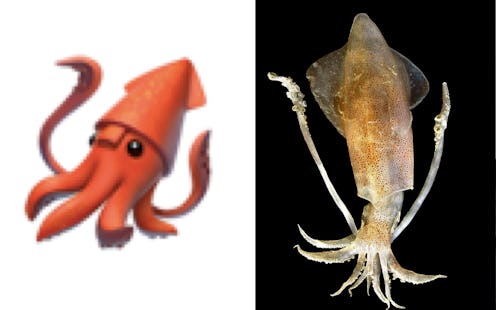Life
An Aquarium In California Called Out The Squid Emoji For This Major Design Flaw

Whether you're an early adopter or a begrudging tap-backer, you probably come into contact with emojis everyday. While hieroglyphs and symbols have been part of human communication for thousands of years, emojis are now the modern way to wear your heart on your sleeve, literally. But while most emojis are designed with fun in mind, a California aquarium recently got one emoji in hot water over a subtle design quirk. On Dec. 5, the Monterey Bay Aquarium tweeted that Apple's squid emoji is upside down, FastCompany reported, and therefore inaccurate. Bustle reached out to Apple for comment, and we will update this story when we hear back.
The issue, it appears, has something to do with a part of the squid called a siphon. While the siphon on the squid emoji is on the front of the squid, making it look like a part of its face, on a real, non-animated squid, the siphon is underneath what would be the equivalent front part of the squid. The siphon expels force to propel squids forwards, and is also the source of their major defense mechanism, the famous cloud of ink. Siphons aren't noses, but the design team appears to have put the siphon in the place of one.
The real problem, according to the aquarium, is that these squid and other emojis, which were introduced in 2016, don't exactly help people feel more attached to the ocean and its sealife. If we go around thinking that squid have cute little noses (and, it must be added, only six arms), we're more likely to feel creeped out when we get a look at a real squid in the wild or an aquarium. Gizmodo notes that this version of the emoji was approved all the way back in 2016 — meaning, no one noticed the squid issue for two years.
Emojis can be political these days. For World Emoji Day, Sky Ocean Rescue campaigned to ask Apple to remove its plastic cup and straw emoji to emphasize the impact that plastic pollution has on the oceans. While that campaign has not led to fruition, public outrage over the insufficiently delicious-looking new bagel emoji in 2018 led to a redesign involving cream cheese.
And the use of emojis to create awareness for animals and sea creatures is actually pretty old news; the WWF started a campaign back in 2015 to raise money for endangered animals by producing 17 emojis, including the giant panda, Galapagos penguin, tiger and bluefin tuna, and encouraging people to donate 10 cents for every time they retweeted them. Adorable and world-saving.
It's worth noting, as Quartz points out, that different versions of the squid emoji across other operating systems are anatomically correct, or as anatomically correct as a cartoon squid can be. It's also not clear how many of us have actually used the squid in an everyday text conversation. For now, if you're tempted to talk about squids and other cephalopods on an Apple device, remember that you're basically using an emoji with its butt on its face.